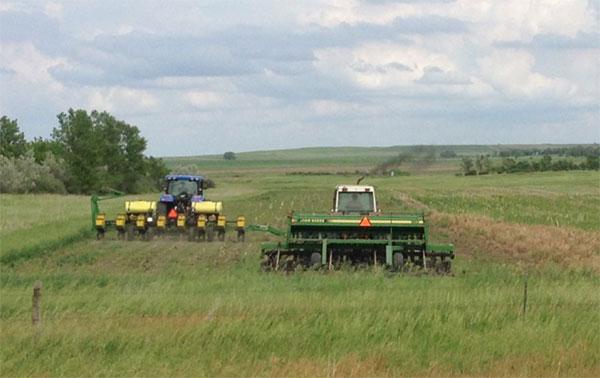
Spring Food Plot Planting

June 26, 2015 by Dillon Springer
While pheasant hunting or talking about pheasant hunting with anybody the term “food plot” tends to come up often. You can’t talk about surfing without referencing the ocean or mountain climbing without the mountain. Pheasant hunting and “food plots” are no different here in South Dakota. To begin with, I would like to clarify what a food plot actually is. It is any form of crop that is planted specifically for wildlife to utilize. Typically, it is planted as an afterthought on a farm next to a shelter belt or adjacent to wetlands and draws. Some farmers will put a narrow band of corn or milo off on its own but we mostly lean towards milo, or its proper name of sorghum, because the birds flourish in it and it doesn’t get too tall to hunt.

The different sorghum seed varieties we used this year.
A food plot here and there is usually sufficient for your average farmer who wants to provide some fun for family or friends that might stop by over the holidays or the opening weekend. But when you own and manage a premiere pheasant hunting destination in the heart of South Dakota the food plot planted as an afterthought just won’t cut it anymore. More planning and consideration goes into our food plot planting than any of our other cash crops (corn and soybeans). There are many different varieties of sorghum (milo) out there. There are red colored species, white colored species, and brown colored ones. Each of these can grow to different heights so it is important to choose the seed varieties that will suit our needs. We like to use waist high reds and whites to offer some contrast in color to our fields.

Planting our food plots with the planter on the left and the drill on the right.
After we have chosen our milo types that we want to plant, we then have to choose a method of planting it that will be equally beneficial to the birds as well as the hunters. Pheasants love this cover but anybody who has had to walk thick cover all day looking for their limit will tell you that the pheasants are the only ones who love thick cover. So, we have found a way of planting our milo that works well for both. We have an 8 row planter that plants the seeds in neat rows 36” apart. We also have a grain drill that plants the seeds in more narrow lines which are only 10” apart. With the drill we will purposely plug up a few holes so there will be 30” walking lanes within this thicker planted milo sections. Now, if you take both of these planting methods and you put them side by side we have found out that we get the best of both worlds. Dad (Marshall) and I will go out and run our tractors and planters side by side and plant all of our food plots like this. When the milo grows up it is a beautiful mixture of reds and whites growing in variable thicknesses which both pheasant hunters and pheasants alike will thoroughly enjoy. Well, the hunters will enjoy it more, I would assume, because nobody is walking around with a shotgun looking for them!
So, the next time you are up here walking the “food plots” looking for that explosion of South Dakota’s pheasants to burst out of the cover you will be able to look down and see that the food plots are just as big of a part of the hunt as the gun and dog are. It’s the little details that truly make a great hunt possible.
Dillon Springer
Posted In: Lodge/Farm News
